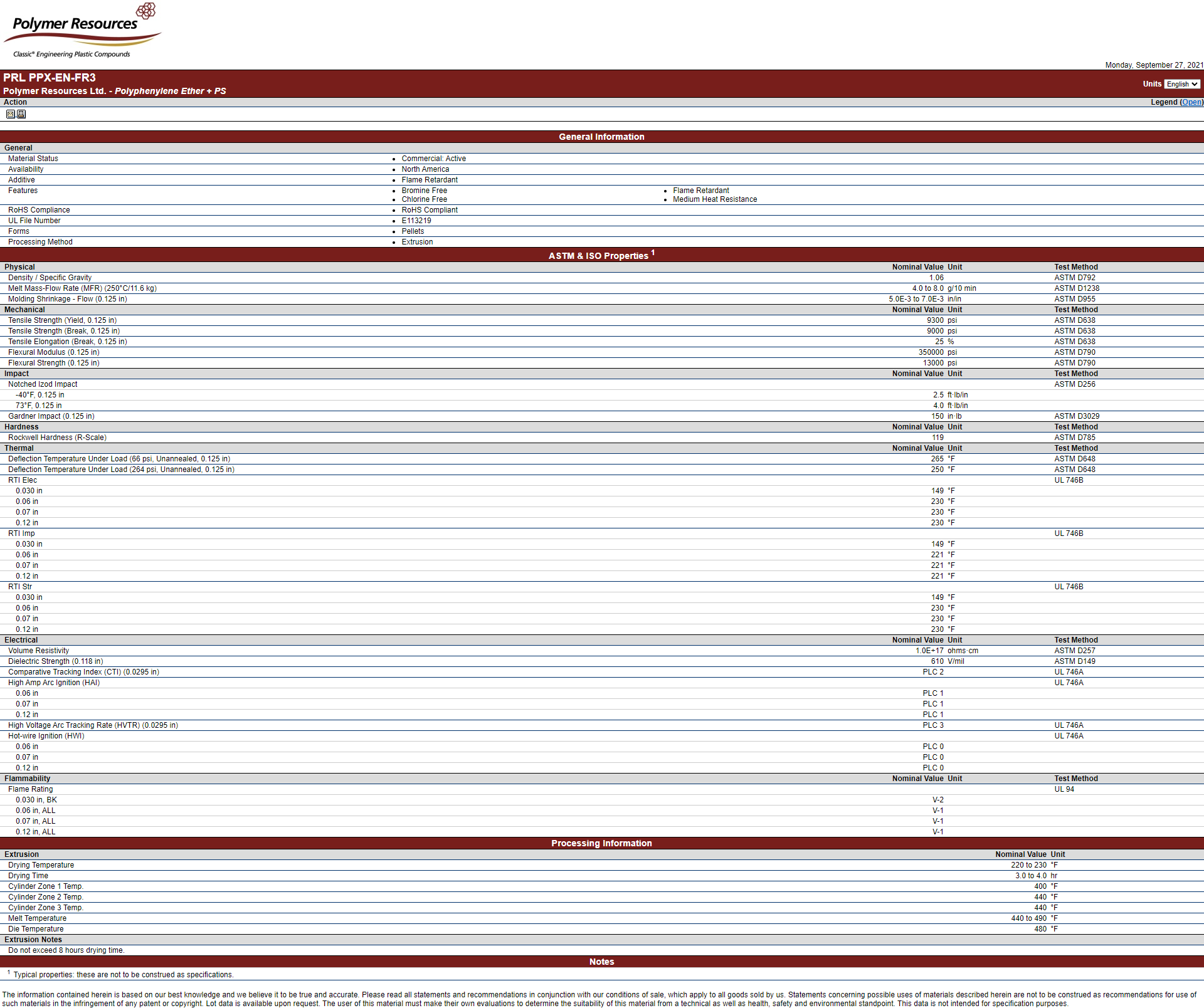PPX Resin
What is PPX Resin?
PPX resin is a blend of polyphenylene ether (PPE) and polystyrene. The PPX blends are unique in that unlike other resin systems, the two polymers are totally compatible in all proportions. Because of this unique characteristic, polyphenylene products can be made with heat distortions that range from a low of 170 F (styrene) to a high of over 350 F (PPE). With different ratios of the two resins, and the incorporation of additive packages for impact strength (non-brominated FR, reinforcements etc.) a family of products can be made featuring UL-VO to UL HB and UL 5V, high stiffness, and or high impact and process ability. Both resins are inherently hydrolytically stable that makes the blends suitable over a wide temperature and humidity range.
The polyphenylene products exhibit a unique feature of retention of tensile and flexural strength and low creep even at elevated temperature.
Impact strength of polyphenylene family of products is typically unaffected by factors such as humidity and only slightly by temperature and wall thickness. A key advantage of PPX resins is that they maintain their impact strength, even at sub-zero temperature.
- Additives – UV stability, easy release (mold releases), colorants, and other stability additives
- Modifiers – Flame retardants, impact modifiers, flow enhancers
- Reinforcing Agents – Glass fibers, mineral fillers
Additives, Modifiers, and Reinforcing Agents:
PRL Alternative Material Solutions to
Example: If you’re looking for Asahi Xyron alternatives or Sabic Noryl alternatives: find the product in the relevant row and look to the leftmost row to find our alternative.
PRL Grades
- PRL PPX-GP1
- PRL PPX-GP2
- PRL PPX-GP3
- PRL PPX-GP3-IM
- PRL PPX-GP4
- PRL PPX-GP5
- PRL PPX-GP6
- PRL PPX-GP7
- PRL PPX-GP8
- PRL PPX-GP1 [COLOR]EN
- PRL PPX-G10
- PRL PPX-G20
- PRL PPX-G30
- PRL PPX-FRG10
- PRL PPX-FRG20
- PRL PPX-FRG30
- PRL PPX-SF1
- PRL PPX-SF2
- PRL PPX-MF-FR1
- PRL PPX-MF-FR3
- PRL PPX-FR1
- PRL PPX-FR2
- PRL PPX-FR3
- PRL PPX-FR4
- PRL PPX-FR5
- PRL PPX-FR6
- PRL PPX-FR1 [COLOR] EN
- PRL PPX-FR2 [COLOR] EN
- PRL PPX-EN-FR3
- PRL PPX/NY GP1
- PRL PPX/NY GP2
- PRL PPX/NY G10
- PRL PPX/NY G20
- PRL PPX/NY G30
Asahi Xyron™ Alternative
- 500H, 600H
- 500H, 600H
- 400H, 450H
- 200H, 300H
- 600H
- X9108, 650H
- X9108, 650H
- 600H
- G701H
- G702H
- G703H
- G701V
- G702V
- G703V
- F100Z, F220Z
- F200Z
- 100Z, 140Z, 220Z, 240Z
- 100V, 140V, 220V, 240V, 240W, 300V, 340V, 340W
- 500V, 540V, 640V, 740V
- 100V, 140V
- 300Z, 340Z, 500Z, 540Z
- 500Z, 540Z, 640Z
- 100Z, 140Z, 220Z, 240Z
- 100V, 140V, 220V, 240V, 240W, 300V, 340V, 340W
- 500V, 540V, 640V, 740V
- AT 610
- AT 600
- AG511
- AG512
- AG213
SABIC Noryl® Alternative
- 731
- PX0888
- PX0844,SPN420
- EM6100, EM6101
- EM7100, SPN410
- PX1265
- PX1390
- PX1391
- PX1222
- EN265
- GFN1
- GFN2
- GFN3
- SE1GFN1
- SE1GFN2
- SE1GFN3
- FN150X, FN170X, FN215X
- FN215X
- HX1000X
- HX2000X
- N190X, PX1600, PX1005, PX5622
- SE100X, PX1700
- SE1X
- PC180X
- N225X
- PX9406
- EN185
- EN212
- EN265
- GTX 902; GTX 918
- GTX 910
- GTX 810
- GTX 820
- GTX 830
PRODUCT Q&As
Q. What are the advantages and disadvantages of modified polyphenylene ether resins?
Q. Is PPE a thermoplastic?
Q. Is PPE amorphous or crystalline?
Q. What applications are PPE used for?
Our Mission
My mission at Polymer Resources has not changed since I founded this company more than four decades ago. It includes continuing our tradition of financial stability, sustainable growth and visionary leadership that compounds success for customers, suppliers and employees. It also means proudly manufacturing our products in America, and making them available to the global marketplace.
Les Klein, Chief Executive Officer, Polymer Resources, Ltd.


 Print
Print Download
Download Email
Email

